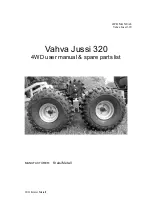
Page 30
Appendix E Optional RS-232 Control
BD500 Broadcast Profanity Delay
©Eventide Inc. 1995-1999
doc release 10
RS-232 Protocol
0
requests static at 0 delay ............. puts the unit in-line. If broadcast delay, puts the unit at 0 delay. If PFD goes to last delay.
1
increments PFD digit ................... Note: PFD must be entered via configuration change to the run mode parameter (run).
2
decrements PFD digit
3
selects PFD digit
5
starts mute .................................. use the K command to unmute. Works in PFD and broadcast delay.
6
initiates pause ............................. use in broadcast delay from live to insert station identification.
7
initiates ramp to bypass ............... in broadcast delay performs ramp to zero and then automatically switches to bypass.
A
initiates wait and exit
B
switches to bypass mode
C
requests config values ................. shows current settings of each of the config values. This long response includes multiple records.
Each record consists of a 3 byte config variable name, followed by an ASCII equal sign (=), fol-
lowed by a 3 byte config value, followed by hex 0D (carriage return). After the last record will be
an a >. None of the 3 byte values contain >. The records correspond to configuration items de-
scribed in chapter 3 and are all ASCII characters of the set 0 through 9, A through Z, space and
dash. Records which have no configurable values will have "NA " (3 bytes) instead of the 3 byte
value.
D
performs a dump
E
entire config table ........................ dump entire config table, all variables, all available values. This long response includes multiple
records. Each record consists of a 3 byte config variable name, followed by an ASCII equal sign
(=), followed by one or more 3 byte strings, each containing config values, separated by spaces,
followed by a space and then hex 0D (carriage return). After the last record will be a >. None of
the 3 byte values contain >. The records correspond to configuration items described in Chapter
3 and are all ASCII characters of the set 0 through 9, A through Z, space and dash. Records
which have no configurable values will have "NA " (2 bytes and a space) instead of 3 byte strings.
F
go to static at full delay
G
go to next config variable ............. steps to next config value. Responds with normal !>. Use X to request current config variable
name and value. See also C, E, J, N, Q, V, X, and Y commands.
H
go to static at current delay ......... If in broadcast delay mode goes to in-line, static and at full delay.
I
requests debugging info .............. responds with machine state name and current delay amount. This is for debugging only, may
change, and is redundant with the M and T commands.
J
store config variable .................... write the current config variable's value into permanent storage.
K
ends a sneeze
L
requests levels ............................ three character response is left channel level followed by right channel level and terminated with
>. Levels are reported using one digit ASCII hex of range 0 through 9, and A. Example: 25> is
left channel level of 2, right channel of 5.
M
requests mode ............................ response is three characters of the form !n> where n is the current mode. Modes are A <wait
and exit>, B <bypass>, D <dump>, G <gapless>, H <static>, L <live>, M <mute>, P <precision
fixed delay>, R <rebuild>, S <sneeze>, W <wait for safe>, Z <ramp to zero>. Note: zero delay
and maximum delay are not modes; if the unit reaches maximum delay while in rebuild mode, the
unit remains in rebuild mode; though if the unit reaches zero delay it switches to static mode.
N
next config value ......................... steps the current config variable to the next value. Responds with normal "!>". This command
does not change the stored config value, only the used value. Use the J command to save the
current config variable. Use X to request current config variable name and value. See also G
command.
P
requests PFD delay ..................... six character response is four digit decimal ASCII value of delay in milliseconds, followed by po-
sition indicator (1, 2, 3 or 4), followed by >. Note: This does not change the mode to PFD.
Q
resets config stepping ................. points at start of config mode. Used with C, E, G, J, N and V, X, and Y commands to make con-
figuration changes to the BD500.
R
initiates rebuild
S
starts a sneeze ............................ See K command for end-sneeze.
T
requests current delay ................. four character response is three digit decimal ASCII value of delay in 10s of milliseconds, followed
by >.
U
requests current delay/hex .......... send delay amount in hexadecimal using 3 characters of ASCII/hex followed by >.
V
Eventide Factory Defaults ........... request factory defaults for all config variables. Note: Allow 400mS before "!>"
W
initiates wait for safe .................... Note: when the unit reaches safe, it will switch to rebuild mode.
X
examine config ............................ gives current config variable and value. Responds with an 8-character message consisting of a
three character config variable identifier, an ASCII equal sign (=), the three character value of the
config variable, and a >. See G, N and Q.
Y
first value .................................... sets the current config variable to the first value. Useful for making automated configuration
changes. See C, E, G, J, N, Q, V and X commands.
Z
initiates ramp to zero
















































